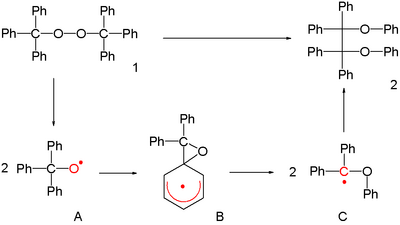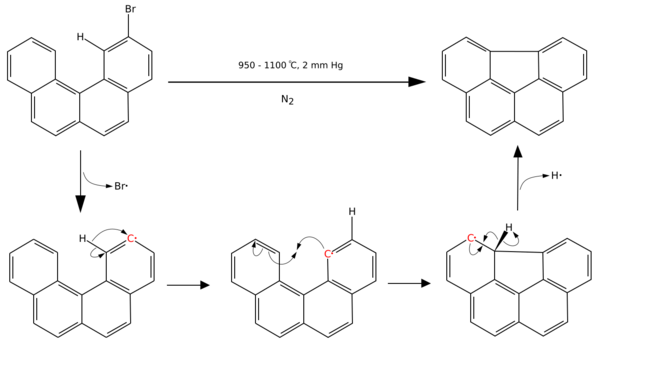Chemistry:1,2-rearrangement
A 1,2-rearrangement or 1,2-migration or 1,2-shift or Whitmore 1,2-shift[1] is an organic reaction where a substituent moves from one atom to another atom in a chemical compound. In a 1,2 shift the movement involves two adjacent atoms but moves over larger distances are possible. In the example below the substituent R moves from carbon atom C2 to C3.
The rearrangement is intramolecular and the starting compound and reaction product are structural isomers. The 1,2-rearrangement belongs to a broad class of chemical reactions called rearrangement reactions.
A rearrangement involving a hydrogen atom is called a 1,2-hydride shift. If the substituent being rearranged is an alkyl group, it is named according to the alkyl group's anion: i.e. 1,2-methanide shift, 1,2-ethanide shift, etc.
Reaction mechanism
A 1,2-rearrangement is often initialised by the formation of a reactive intermediate such as:
- a carbocation by heterolysis in a nucleophilic rearrangement or anionotropic rearrangement
- a carbanion in an electrophilic rearrangement or cationotropic rearrangement
- a free radical by homolysis
- a nitrene.
The driving force for the actual migration of a substituent in step two of the rearrangement is the formation of a more stable intermediate. For instance a tertiary carbocation is more stable than a secondary carbocation and therefore the SN1 reaction of neopentyl bromide with ethanol yields tert-pentyl ethyl ether.
Carbocation rearrangements are more common than the carbanion or radical counterparts. This observation can be explained on the basis of Hückel's rule. A cyclic carbocationic transition state is aromatic and stabilized because it holds 2 electrons. In an anionic transition state on the other hand 4 electrons are present thus antiaromatic and destabilized. A radical transition state is neither stabilized or destabilized.
The most important carbocation 1,2-shift is the Wagner–Meerwein rearrangement. A carbanionic 1,2-shift is involved in the benzilic acid rearrangement.
Radical 1,2-rearrangements
The first radical 1,2-rearrangement reported by Heinrich Otto Wieland in 1911[2] was the conversion of bis(triphenylmethyl)peroxide 1 to the tetraphenylethane 2.
The reaction proceeds through the triphenylmethoxyl radical A, a rearrangement to diphenylphenoxymethyl C and its dimerization. It is unclear to this day whether in this rearrangement the cyclohexadienyl radical intermediate B is a transition state or a reactive intermediate as it (or any other such species) has thus far eluded detection by ESR spectroscopy.[3]
An example of a less common radical 1,2-shift can be found in the gas phase pyrolysis of certain polycyclic aromatic compounds.[4] The energy required in an aryl radical for the 1,2-shift can be high (up to 60 kcal/mol or 250 kJ/mol) but much less than that required for a proton abstraction to an aryne (82 kcal/mol or 340 kJ/mol). In alkene radicals proton abstraction to an alkyne is preferred.
1,2-Rearrangements
The following mechanisms involve a 1,2-rearrangement:
- 1,2-Wittig rearrangement
- Alpha-ketol rearrangement
- Beckmann rearrangement
- Benzilic acid rearrangement
- Brook rearrangement
- Criegee rearrangement
- Curtius rearrangement
- Dowd–Beckwith ring expansion reaction
- Favorskii rearrangement
- Friedel–Crafts reaction
- Fritsch–Buttenberg–Wiechell rearrangement
- Halogen dance rearrangement
- Hofmann rearrangement
- Lossen rearrangement
- Pinacol rearrangement
- Seyferth–Gilbert homologation
- SN1 reaction (generally)
- Stevens rearrangement
- Stieglitz rearrangement
- Wagner–Meerwein rearrangement
- Westphalen–Lettré rearrangement
- Wolff rearrangement
References
- ↑ Whitmore, Frank C. (1932). "The common basis of molecular rearrangements". Journal of the American Chemical Society 54 (8): 3274–3283. doi:10.1021/ja01347a037.
- ↑ Über Triphenylmethyl-peroxyd. Ein Beitrag zur Chemie der freien Radikale Wieland, H. Chem. Ber. 1911, 44, 2550–2556. doi:10.1002/cber.19110440380
- ↑ Isomerization of Triphenylmethoxyl and 1,1-Diphenylethoxyl Radicals. Revised Assignment of the Electron-Spin Resonance Spectra of Purported Intermediates Formed during the Ceric Ammonium Nitrate Mediated Photooxidation of Aryl Carbinols K. U. Ingold, Manuel Smeu, and Gino A. DiLabio J. Org. Chem.; 2006; 71(26) pp 9906–9908; (Note) doi:10.1021/jo061898z
- ↑ Brooks, Michele A.; Lawrence T. Scott (1999). "1,2-Shifts of Hydrogen Atoms in Aryl Radicals". Journal of the American Chemical Society 121 (23): 5444–5449. doi:10.1021/ja984472d.
 |




